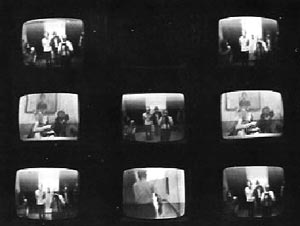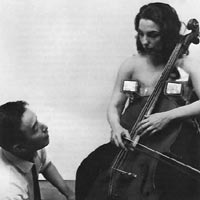[ index | VIDEO | 1969 ]
TV as a Creative Medium
On May 17, 1969, a show which was to become the seminal exhibition of video art in the U.S. opened at the Howard Wise Gallery in New York City. That exhibition, "TV as a Creative Medium", effectively pointed to the diverse potential of a new art form and social tool. Subsequently, the show became renowned for the inspiration it provided for many artists and future advocates of video.
The centerpiece of "TV as a Creative Medium" was Wipe Cycle, by Gillette and Schneider, which greeted viewers upon their entry into the gallery from the elevator. The piece consisted of a grid of nine monitors; a camera hidden amid the monitors fed a live image to the center screen. This image was switched to the outer monitors in eight- and 16-second intervals so that at any given time the viewers could see themselves eight or 16 seconds before. These live images intercut with broadcast images, and at periodic intervals the screens were wiped blank. Wipe Cycle was one of the first video installations to involve the viewer in an active role on the screen (23) it provided an element of surprise and its correlation between the viewer's image and broadcast imagery emphasized the individual's relationship to information.

Wipe Cycle remains a complex and intriguing work. As critic Richard Kostelanetz wrote, "The spectator feels caught in an intelligent, watchful, oblivious system whose incessant and variable observations remain compelling and mysterious even after their operation is explained." (25)
Another outstanding work in the exhibition was Paik's TV Bra for Living Sculpture, an ongoing performance by avantgarde cellist Charlotte Moorman. Wise had followed the work of Moorman and Paik for several years. When the duo was arrested in 1967 at the Film-Maker's Cinematheque during a performance of Paik's Opera Sextronique, (26) Wise allowed Moorman to conduct a press conference in his gallery, providing her with the respectable background of the 57th St. art establishment as she stated her case.

In "TV as a Creative Medium" Paik premiered both Participation TV, and TV Bra (Moorman still performs the latter). "We were all surprised by the response to that piece," she says, "it is so popular." (27) In TV Bra, Moorman wears two small TV sets on her breasts while playing the cello. As she plays, her music alters the imagery on the monitors. Participation TV is an interactive piece with images of viewers generated in different colors on several monitors.
Many of the works in "TV as a Creative Medium" involved restructuring television sets. In John Serry's TV Time Capsule a TV set was cast in clear plastic so that its insides were made visible. The set played continuously, burning itself out twice during the show. Wrote Seery, "When the TV stops functioning the work is complete."(28) In Three Experiments within the TV Tube, Earl Reiback, a light sculpture protege of Wilfred, whose background was nuclear engineering, painted the wall of a television tube with color phosphors. Viewers of his Electron Beam could manipulate an external magnet to effect the phosphors' movements. In Suspension and Thrust this technique was applied to broadcast television.
Other works dealt with the potential to incorporate art into commercial television and the consumer environment. AC/TV (Audio-Controlled Television), by Joe Weintraub, was a device which translated "music into a complex kinetic image on the screen of any color TV." (29) Tadlock's Archetron presented a large console consisting of three monitors and an elaborate system of mirrors and filters to create kaleidoscopic imagery from broadcast TV. "It is not possible for this artist, (or any other using the Archetron)," wrote Wise in the exhibition brochure, "in effect to create simultaneously works of art on TV screens in countless homes." Boutourline's Telediscretion contained four television sets lined up on a wall, controlled by a switch which allowed viewers to choose among broadcast programs and a videotape by Boutourline and Wynn Chamberlain. The emphasis on the role of the viewer and the viewer's freedom to choose in all of these works indicates the hands-on, take-control-of-television attitude which informed much early video art.
Several other pieces in the show concentrated on abstract electronic imagery and image/sound relationships. Black Spiral, by Aldo Tambellini, was produced in collaboration with Bell Laboratories. It is a riveting videotape that filmmaker and critic Jud Yalkut has described as "a high-contrast spiralling white light, [which] shimmers, radiates, contracts, twists in orgasmic ecstasy, dwindles to nothing, and blazes forth again on the black video field." (30) Eric Siegel's Psychedelevision in Color (31) consisted of three tapes: Einstein, a manipulated image sequence of Albert Einstein's face, where his features radiate color and abstract imagery; Symphony of the Planets; and Tomorrow Never Knows, accompanied by the Beatles song. Both of the latter tapes display psychedelic imagery in conjunction with music, and Siegel jokingly refers to Tomorrow Never Knows, as "a kind of very early rock video." Today, however; this work looks like much more. Siegel's exploration of relationships between abstract imagery and sound entails sophistication not unlike that in the experimental films of Oskar Fischinger.
Wise's step into electronic art, however, was an irreversible one. Within a year and a half after "TV as a Creative Medium" he closed his gallery and began plans for an organization designed to foster the work of video artists and their use of new technologies. That organization eventually became known as Electronic Arts Intermix (EAI).
- Marita Sturken, May 1984, Afterimage, Vol. 11, No. 10
NOTES
1. TV as a Creative Medium (exhibition brochure), (New York: Howard Wise Gallery, 1969), n.p.
23. Les Levine produced two installations, Iris (1968) and Contact: A Cybernetic Sculpture (1969), which were important predecessors to Wipe Cycle, although less complex. In Iris, six monitors in a grid show imagery of viewers in close-up, mid-range, and wide angle; in Contact, the concept of Iris is extended with similar imagery on 18 monitors (nine on either side), with images switching from screen to screen.
24. TV as a Creative Medium, op. cit.
25. Richard Kostelanetz, "Artistic Machines," Chicago Review, Vol.23, No.1 (1971), p. 124.
26. Moorman was convicted of indecent exposure for performing semi-nude. Paik, as the composer, was acquitted.
27. All quotes from Charlotte Moorman are from an interview with the author, Sept. 17, 1983.
28. TV as a Creative Medium, op. cit.
29. Ibid.
30. Jud Yalkut, "TV as a Creative Medium," Arts Magazine (September-October 1969), p. 22.
31. Siegel added "in color" to the title of the tape because color videotapes were unusual at the time.
[ index | 1969 ]